CMU凸优化笔记–凸集和凸函数
结束了一段时间的学习任务,于是打算做个总结。主要内容都是基于CMU的Ryan Tibshirani开设的Convex Optimization课程做的笔记。这里只摘了部分内容做了笔记,很感谢Ryan Tibshirani在官网中所作的课程内容开源。也很感谢韩龙飞在CMU凸优化课程中的中文笔记,我在其基础上做了大量的内容参考。才疏学浅,忘不吝赐教。
1、凸集合
1.1 基本概念
定义:给定一个集合C⊆Rn” role=”presentation” style=”position: relative;”>C⊆RnC⊆Rn,满足下列条件则称为凸集
x,y∈C⇒tx+(1−t)y∈C” role=”presentation” style=”position: relative;”>x,y∈C⇒tx+(1−t)y∈Cx,y∈C⇒tx+(1−t)y∈C
直观上看,可以利用下图帮助理解,假定我们的变量在二维空间中,x,y” role=”presentation” style=”position: relative;”>x,yx,y张成的集合空间中。
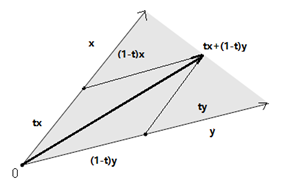
那么从定义出发,我们也能知道非凸集的情况,下图左侧为凸集,右图为非凸集
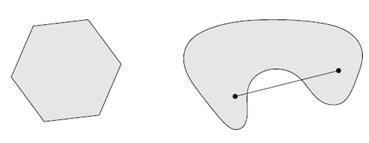
一句话来概括凸集就是集合内任意两点间连线依旧在集合内。

1.2 凸集简单例子
- 凸包(convex hull):给定集合内的任意k” role=”presentation” style=”position: relative;”>kk,任意的线性组合形式:
θ1x1+...+θkxk,θi≤,i=1,...,k” role=”presentation” style=”position: relative;”>θ1x1+...+θkxk,θi≤,i=1,...,kθ1x1+...+θkxk,θi≤,i=1,...,k。convex hull总是凸的。可以直观认为凸包就是最外围的元素所围成的集合外壳,下图是两个凸包的例子:
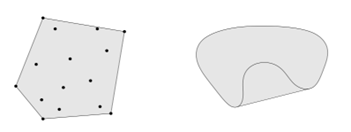
- 空集、点、线都是凸集合
- 范数球(Norm ball): 半径为r” role=”presentation” style=”position: relative;”>rr
- 超平面(Hyperplane): 给定任意a,b” role=”presentation” style=”position: relative;”>a,ba,b
- 半空间(Half space): {x:aTx≤b}” role=”presentation” style=”position: relative;”>{x:aTx≤b}{x:aTx≤b}
- 仿射空间(Affine space):{x:Ax=b}” role=”presentation” style=”position: relative;”>{x:Ax=b}{x:Ax=b}
- 多面体(Polyhedron):{x:Ax≤b}” role=”presentation” style=”position: relative;”>{x:Ax≤b}{x:Ax≤b},下图为多面体
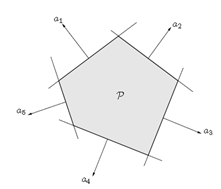
Note:集合{x:Ax≤b,Cx=d}” role=”presentation” style=”position: relative;”>{x:Ax≤b,Cx=d}{x:Ax≤b,Cx=d}也是一个Polyhedron吗?
Answer:是的。因为对于任意的Cx=d” role=”presentation” style=”position: relative;”>Cx=dCx=d形式一致。
1.3 锥(Cone):
定义:给定C∈Rn” role=”presentation” style=”position: relative;”>C∈RnC∈Rn称之为锥。
凸锥(convex cone):x1,x2∈C⇒t1x1+t2x2∈C” role=”presentation” style=”position: relative;”>x1,x2∈C⇒t1x1+t2x2∈Cx1,x2∈C⇒t1x1+t2x2∈C为凸锥。显然凸锥是锥的一种。
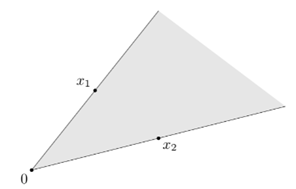
例子:
范数锥(Norm cone):{(x,t):||x||≤t}” role=”presentation” style=”position: relative;”>{(x,t):||x||≤t}{(x,t):||x||≤t}做出了三维情况下的图:
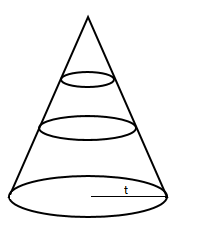
正规锥(Normal cone):给定任意集合C” role=”presentation” style=”position: relative;”>CC,定义:
Nc(x)={g:gTx≥gTy,foranyy∈C}” role=”presentation” style=”position: relative;”>Nc(x)={g:gTx≥gTy,foranyy∈C}Nc(x)={g:gTx≥gTy,foranyy∈C}
其含义是指Normal cone中的点与集合C” role=”presentation” style=”position: relative;”>CC内的点的内积永远大于集合内任意点与Normal cone内点的内积。如下图所示:
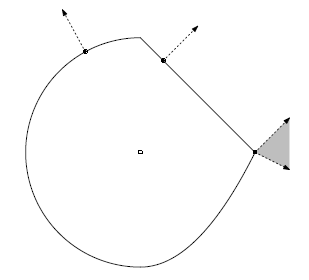
1.4 凸集的一些特性
- 可分离超平面理论(Separating hyperplane theorem):两个不相交的凸集总存在一个超平面能将两者分离,如果C⋂D=∅” role=”presentation” style=”position: relative;”>C⋂D=∅C⋂D=∅使得有:
C⊆{x:aTx≤b}” role=”presentation” style=”position: relative;”>C⊆{x:aTx≤b}C⊆{x:aTx≤b}。如下图所示:
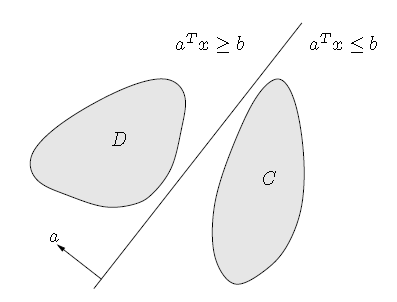
- 支撑超平面理论(Supporting hyperplane theorem):凸集边界上的一点必然存在一个支撑超平面穿过该点,即如果C” role=”presentation” style=”position: relative;”>CC。如下图:

1.5 保凸操作
- 集合交(Intersection):任何凸集之交产生的集合依旧是凸集。
- 缩放和平移(Scaling and translation):假设C” role=”presentation” style=”position: relative;”>CC也是凸的。
- 仿射映射与预映射(Affine images and preimages):如果f(x)=Ax+b” role=”presentation” style=”position: relative;”>f(x)=Ax+bf(x)=Ax+b也是凸的。
1.6 凸集与保凸操作相关例子
条件概率集合(conditional probability set):U,V” role=”presentation” style=”position: relative;”>U,VU,V
2 、凸函数
2.1 基本概念
定义:给定映射f:Rn→R” role=”presentation” style=”position: relative;”>f:Rn→Rf:Rn→R为凸集,那么
f(tx+(1−t)y)≤tf(x)+(1−t)f(y)” role=”presentation” style=”position: relative;”>f(tx+(1−t)y)≤tf(x)+(1−t)f(y)f(tx+(1−t)y)≤tf(x)+(1−t)f(y)。如下图:
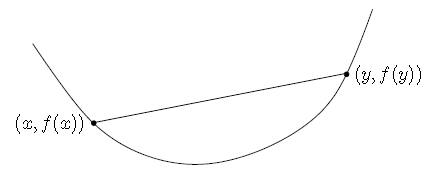
从上图可以看出,f” role=”presentation” style=”position: relative;”>ff之间的直线下方。
Note:
- 严格凸(Strictly convex):对于任意x≠y” role=”presentation” style=”position: relative;”>x≠yx≠y比线性函数要更弯曲
- 强凸(Strongly convex):对于参数m>0” role=”presentation” style=”position: relative;”>m>0m>0要比一般的二次函数要弯曲。
- 强凸 ⇒” role=”presentation” style=”position: relative;”>⇒⇒ 凸
2.2 凸函数例子
- 单变量函数:
例如指数函数eax” role=”presentation” style=”position: relative;”>eaxeax是非凸函数
- 仿射函数(Affine function):
aTx+b” role=”presentation” style=”position: relative;”>aTx+baTx+b既是凸函数又是非凸函数
- 二次函数(Quadratic function):
12xTQx+bTx+c” role=”presentation” style=”position: relative;”>12xTQx+bTx+c12xTQx+bTx+c(半正定)的时候为凸
- 最小平方损失函数(Least squares loss):
||y−Ax||22” role=”presentation” style=”position: relative;”>||y−Ax||22||y−Ax||22总是半正定的
- 范数(Norm):
||x||” role=”presentation” style=”position: relative;”>||x||||x||。
谱(spectral)范数:∥X∥op=σ1(X)” role=”presentation” style=”position: relative;”>∥X∥op=σ1(X)∥X∥op=σ1(X),
核范数(nuclear):||X||tr=∑i=1rσr(X)” role=”presentation” style=”position: relative;”>||X||tr=∑ri=1σr(X)||X||tr=∑i=1rσr(X)的从大到小排序的奇异值。
- 指示函数(Indicator function):
如果C” role=”presentation” style=”position: relative;”>CC为凸函数。
- 最大值函数(Max function):
f(x)=max{x1,...,xn}” role=”presentation” style=”position: relative;”>f(x)=max{x1,...,xn}f(x)=max{x1,...,xn}为凸函数
2.3 凸函数的一些特性
- 上镜特性(Epigraph characterization):函数f” role=”presentation” style=”position: relative;”>ff为凸集,如下图:
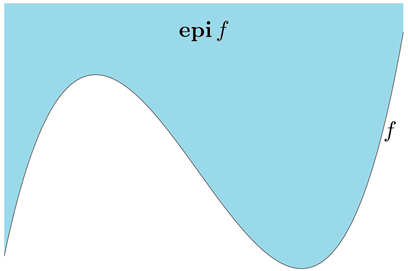
- 一阶特性(First-order characterization):假设f” role=”presentation” style=”position: relative;”>ff。
Note:如何证明凸函数的一阶特性?
Answer:从凸函数定义出发,f(ty+(1−t)x)≤tf(y)+(1−t)f(x)⇒f(t(y−x)+x)+f(x))≤t(f(y)−f(x))+f(x)⇒f(t(y−x)+x)−f(x)t(y−x)≤fracf(y)−f(x)y−x⇒limt→0f(t(y−x)+x)−f(x)t(y−x)=∇f(x)⇒∇f(x)(y−x)≤f(y)−f(x)⇒f(y)≥f(x)+∇f(x)(y−x)” role=”presentation” style=”position: relative;”>f(ty+(1−t)x)≤tf(y)+(1−t)f(x)⇒f(t(y−x)+x)+f(x))≤t(f(y)−f(x))+f(x)⇒f(t(y−x)+x)−f(x)t(y−x)≤fracf(y)−f(x)y−x⇒limt→0f(t(y−x)+x)−f(x)t(y−x)=∇f(x)⇒∇f(x)(y−x)≤f(y)−f(x)⇒f(y)≥f(x)+∇f(x)(y−x)f(ty+(1−t)x)≤tf(y)+(1−t)f(x)⇒f(t(y−x)+x)+f(x))≤t(f(y)−f(x))+f(x)⇒f(t(y−x)+x)−f(x)t(y−x)≤fracf(y)−f(x)y−x⇒limt→0f(t(y−x)+x)−f(x)t(y−x)=∇f(x)⇒∇f(x)(y−x)≤f(y)−f(x)⇒f(y)≥f(x)+∇f(x)(y−x)
- 二阶特性:如果函数二阶可微分,则f” role=”presentation” style=”position: relative;”>ff
- Jensen不等式:假若f” role=”presentation” style=”position: relative;”>ff
2.4保凸操作
- 非负线性组合
f1,...,fm” role=”presentation” style=”position: relative;”>f1,...,fmf1,...,fm为凸。
- 逐点最大化
如果fs” role=”presentation” style=”position: relative;”>fsfs是凸函数。
- 部分最小化
如果g(x,y)” role=”presentation” style=”position: relative;”>g(x,y)g(x,y)为凸函数。
2.5 证明凸函数例子
对数求和函数(Log-sum-exp function):“soft max”函数:对于给定ai,bi,i=1,...,k” role=”presentation” style=”position: relative;”>ai,bi,i=1,...,kai,bi,i=1,...,k。
那么为了证明凸函数,首先我们知道仿射函数均是凸函数,并且对于求和函数可以看成是f(x)=log(∑i=1nexi)” role=”presentation” style=”position: relative;”>f(x)=log(∑ni=1exi)f(x)=log(∑i=1nexi)为凸函数即可。
∇if(x)=exi∑l=1nexl” role=”presentation” style=”position: relative;”>∇if(x)=exi∑l=1nexl∇if(x)=exi∑l=1nexl
∇ij2f(x)=exi∑l=1n1{i=j}−exiexj(∑l=1nexl)2” role=”presentation” style=”position: relative;”>∇2ijf(x)=exi∑l=1n1{i=j}−exiexj(∑nl=1exl)2∇ij2f(x)=exi∑l=1n1{i=j}−exiexj(∑l=1nexl)2
将上式重写为∇2f(x)=diag(z)−zzT” role=”presentation” style=”position: relative;”>∇2f(x)=diag(z)−zzT∇2f(x)=diag(z)−zzT。这是一个对角占优矩阵,因此是半正定矩阵,因此满足二阶性质。原式为凸函数得证。
